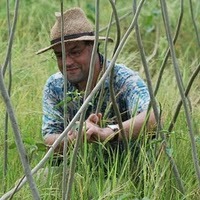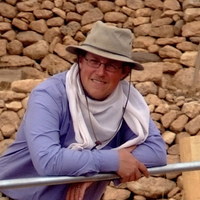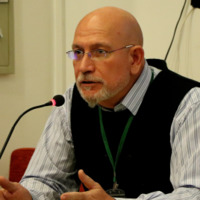Nuovi dati sulla conservazione e sulla cottura di alimenti da due contesti fenicio-punici di Nora (Sardegna, Italia)
La alimentación en el mundo fenicio-púnico: producciones, procesos y consumos, 2020, ISBN 978-84-472-2932-1, págs. 253-274, 2020
Nell’ambito delle ricerche condotte dall’Università degli Studi di Padova presso l’area del cd. T... more Nell’ambito delle ricerche condotte dall’Università degli Studi di Padova presso l’area del cd. Tempio romano di Nora, è stato possibile indagare due contesti di età fenicia e punica di notevole rilevanza per lo studio dell’alimentazione fenicia e punica in Sardegna: un impianto produttivo costituito da un’anfora segata e reimpiegata per la lavorazione o lo stoccaggio della pece (prima metà del VI sec. a.C.) e un forno tannur in straordinario stato di conservazione (II-I sec. a.C.). Le analisi archeobotaniche condotte dal laboratorio di Archeobiologia dei Musei Civici di Como hanno permesso di identificare i combustibili impiegati e tracce dei resti alimentari di origine vegetale e animale, combusti negli ultimi episodi di cottura documentati in situ. Le analisi radiometriche hanno confermato le dazioni crono-tipologiche dei contenitori, mentre lo studio degli impasti dell’anfora e del tannur ha messo in luce la presenza diffusa di degrassanti vegetali, in particolare resti di tegumento riferibile ad orzo vestito, che si conferma così uno dei cereali diffusamente coltivati in Sardegna sin dall’età fenicia.










Uploads
Papers by Mauro Rottoli
The paper presents the entire collection of artefacts and wooden structures preserved at the Museum of Parma from the nineteenth-century excavations of the Terramara of Castione dei Marchesi, active between the Middle Bronze Age and the Late Bronze Age. These are 206 finds recovered partly from Pigorini's 1877 excavations and partly collected by Ludovico Ugolotti, owner of the land. It is possible that a few other objects from other Terramares were also included in the collection. Only 74 artefacts had already been published by Strobel in 1878 and 1881. The study of the artefacts (description, signs of processing, determination of the species) and the comparison with other published materials of the same type allows us to obtain data on the environment, technology and the chronology of the Bronze Age site.
The paper presents the entire collection of artefacts and wooden structures preserved at the Museum of Parma from the nineteenth-century excavations of the Terramara of Castione dei Marchesi, active between the Middle Bronze Age and the Late Bronze Age. These are 206 finds recovered partly from Pigorini's 1877 excavations and partly collected by Ludovico Ugolotti, owner of the land. It is possible that a few other objects from other Terramares were also included in the collection. Only 74 artefacts had already been published by Strobel in 1878 and 1881. The study of the artefacts (description, signs of processing, determination of the species) and the comparison with other published materials of the same type allows us to obtain data on the environment, technology and the chronology of the Bronze Age site.
The excavation provides evidence of sustainable intensive mixed farming: an oil mill and press, a grain hand mill, a sundial, bones of cattle and dromedaries, raised for labour, transport, milk, meat, skins, wool. Remains of fowl, such as a partridge and fragments of ash tree, pine and olive stones were found and analyzed. Local imitations of African Red Slip (ARS) wares are identified for the first time during the excavation of Aïn Wassel and the field survey of the surrounding region. Three new types of amphoras of large dimensions were discovered at Aïn Wassel, and classified as Aïn Wassel 1, 2 and 3. The excavation proved that in the 7th c. AD north Africa was still very active and dynamic, where regional trade used both fluvial and ground transportation. Until recent times, this was considered instead as a period of crisis, abandonment of the countryside and ruralization of cities; it was not so.
In 1891 Louis Carton discovered a Severian copy of the lex divi Hadriani de rudibus agris in the rural site of Aïn Wassel, and this is why in 1994 this site was chosen in order to investigate the work and living conditions of the sharecroppers who had asked Septimius Severus the application of that lex. The lex granted the land for cultivation to the coloni who had requested this application, allowing them to bequeath it to their heirs. Many historic and juridical studies had analyzed this and other six (now seven) so-called ‘great agrarian inscriptions’, which were found in the Medjerda valley, but so far no field research had been conducted. The field survey outlined the history of the settlement, which started on or near the estate of the Late Republican triumphator, Titus Statilius Taurus, who was the brilliant general of Octavian. After the transfer from Statilius’ great-grandson to Agrippina or Nero, the estate took the name of Saltus Neronianus. The application of the lex Hadriana was probably monitored by Caius Rossius Crescens, emissary of Marcus Rossius Vitellus, who was a collaborator of Septimius Severus, and at the end of his carreer decurio, flamen perpetuus and patronus of Bulla Regia. He became also procurator tractus Carthaginiensis and procurator ducenarius IIII publicarum provinciae Africae. Crescens was buried in or near the settlement and his funerary stele with epitaph was reused as building material in the Byzantine farm.
ha costituito un ottimo luogo per lo stabilirsi di insediamenti
nel corso delle prime fasi del Neolitico. La sorveglianza
archeologica, effettuata nel 2011 lungo un tratto di
metanodotto SNAM, ha consentito di individuare nuove
evidenze neolitiche a Cargnacco, non lontano in linea d'aria dal
ben noto sito di Sammardenchia. Le indagini hanno
interessato purtroppo solo un'area molto limitata nell'ambito
del tracciato della linea di posa delle tubature del gas; la
sorveglianza non ha invece rilevato altre evidenze
archeologiche lungo il tracciato del metanodotto. Raccolte di superficie di materiali in selce nei terreni circostanti
confermano comunque la scoperta, suggerendo la presenza di
un abitato neolitico esteso.
The archaeological deposits brought to light have made it possible to identify a stratigraphic sequence with four separate phases of occupation.
In the area investigated it has currently been possible to identify 76 postholes, 70 of which can be related to four residential buildings constructed using load-bearing vertical posts planted in the ground, which can be attributed to three different settlement phases. During the fourth phase of occupation a fifth dwelling was built using a new construction technique with stone foundations , on which the wooden structure rested.
Interdisciplinary research at the Storo Dosso Rotondo site has led to the conclusion that it was probably a seasonal settlement linked to mountain pasture activities. On the basis of the pottery and flint artefacts, occupation of the settlement can be dated to the early phase of the Middle Bronze Age.
All the archaeobotanical data have been correlated with other available environmental data (pedological, geological, geomorphological profiles, current botanical and zoological analyses) to draw a cartographic reconstruction of the distribution of natural vegetation, fields and cultivated land in two different periods: Middle Neolithic (SMP phase) and late Antiquity-medieval (V-VII AD).
Si presentano nuovi dati sui macroresti botanici rinvenuti nella piana di Riva del Garda e nelle aree limitrofe
e una revisione della letteratura sui pollini e sui macroresti botanici delle stesse aree.
I dati archeobotanici sono stati combinati con gli altri dati ambientali disponibili (profili pedologici, geologici, geomorfologici, analisi botaniche e zoologiche attuali) per disegnare una ricostruzione cartografica della distribuzione della vegetazione naturale, dei campi e dei terreni coltivati in due periodi diversi: Neolitico medio (VBQ) e epoca tardo antica-altomedievale (V-VII d.C.).
Vengono presentati i resti vegetali (carboni, semi e frutti, pane) rinvenuti nella necropoli romana di Nave (Brescia, Nord Italia). Si tratta di uno dei primi studi sistematici sulle offerte alimentari e sul combustibile ligneo di una necropoli ad incinerazione romana dell’Italia settentrionale. Sono state analizzate 44 tombe del I sec. a.C. - I sec. d.C. L’offerta alimentare è ricca e variegata, il pane, sebbene in frammenti è presente in molte tombe. La quercia è il combustibile preferito, quasi esclusivo, ed è stata utilizzata anche per la costruzione delle barelle su cui venivano deposti i defunti.